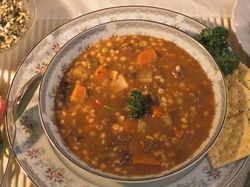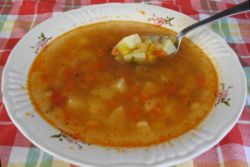Soup
2007 Schools Wikipedia Selection. Related subjects: Drink
Soup is usually a savoury liquid food that is made by combining ingredients, such as meat, vegetables and beans in stock or hot water, until the flavor is extracted, forming a broth. Boiling was not a common cooking technique until the invention of waterproof containers (which probably came in the form of pouches made of clay or animal skin) about 5,000 years ago (possibly longer), so soups presumably were little-known before that time.
Over the centuries, the terms gruel and potage have become separated from broth and stock (and their refinement, consommé). The language may have shifted over time, but the modern definitions of soup and stew were established in the 18th century: soups usually are more liquid; stews are thicker, containing more solid ingredients. Stews are cooked in covered containers for longer periods of time, at a gentle boil with less water and at a lower heat.
Traditionally, soups are classified into two broad groups: clear soups and thick soups. The established French classifications of clear soups are bouillon and consommé. Thick soups are classified depending upon the type of thickening agent used: purées are vegetable soups thickened with starch; bisques are made from puréed shellfish thickened with cream; cream soups are thickened with béchamel sauce; and veloutés are thickened with eggs, butter and cream. Other ingredients commonly used to thicken soups and broths include rice, flour, and grain.
Early history
The word soup originates from " sop", a dish originally consisting of a soup or thick stew which was soaked up with pieces of bread. The modern meaning of sop has been limited to just the bread intended to be dipped.
The word restaurant was first used in France in the 16th century, to describe a highly concentrated, inexpensive soup, sold by street vendors called restaurer, that was advertised as an antidote to physical exhaustion. In 1765, a Parisian entrepreneur opened a shop specializing in restaurers. This prompted the use of the modern word restaurant to describe the shops.
In America, the first colonial cookbook was published by William Parks in Williamsburg, Virginia in 1742, based on Eliza Smith's The Compleat Housewife; or Accomplished Gentlewoman's Companion and it included several recipes for soups and bisques. A 1772 cookbook, The Frugal Housewife, contained an entire chapter on the topic. English cooking dominated early colonial cooking; but as new immigrants arrived from other countries, other national soups gained popularity. In particular, German immigrants living in Pennsylvania were famous for their potato soups. In 1794, Jean Baptiste Gilbert Payplat dis Julien, a refugee from the French Revolution, opened an eating establishment in Boston called Restorator, and became known as "The Prince of Soups." The first American cooking pamphlet dedicated to soup recipes was written in 1882 by Emma Ewing: Soups and Soup Making.
Portable soup was devised in the 18th century by boiling seasoned meat until a thick, resinous syrup was left that could be dried and stored for months at a time. The Japanese miso is an example of a concentrated soup paste.
Today, according to the Campbell Soup Company, chicken noodle soup is one of the most popular soups in America. It is considered by many an effective remedy for the common cold, and is sometimes referred to as "Jewish penicillin" (a reference to the stereotypical fondness of American Jews for chicken soup).
Commercial soup
Commercial soup became popular with the invention of canning in the 19th century.
Dessert soups
- Ginataan, Filipino soup made from coconut milk, milk, fruits and tapioca pearls, served hot or cold.
- Oshiruko, a Japanese azuki bean soup
Fruit soups
Fruit soups are served hot or cold depending on the recipe. Many recipes are for cold soups served when fruit is in season during hot weather. Some like Norwegian 'fruktsuppe' may be served hot and rely on dried fruit such as raisins and prunes and so could be made in any season. Fruit soups may include milk, sweet or savoury dumplings, spices, or alcoholic beverages like brandy or champagne.
Cold fruit soups are most common in Scandinavian, Baltic and Eastern European cuisines while hot fruit soups with meat appear in Middle Eastern, Central Asian and Chinese cuisines. Fruit soups are uncommon or absent in the cuisines of the Americas, Africa and Western Europe. They are also not seen in Japan, Southeast Asia or Oceania.
- Winter melon soup is a Chinese soup, usually with a chicken stock base. It is a savory soup, often including other vegetables and mushrooms. Technically, the winter melon is a fruit, since it is a seed bearing body, but in practical use, it is a vegetable. (see cucumber) Winter melon soup is often presented as a whole winter melon, filled with stock, vegetables and meat, that has been steamed for hours. The skin is decoratively cut, so that what is presented is a decorative centerpiece, smaller than a medicine ball, larger than a soccer ball, filled with soup. The flesh of the melon is scooped out with the soup.
- Sour soup ( fish soup) is a Vietnamese dish made with rice, fish, various vegetables, and in some cases pineapple.
Asian soups
A feature of East Asian soups not normally found in Western cuisine is the use of tofu in soups. Many traditional East Asian soups are typically broths, clear soups, or starch thickened soups. Many soups are eaten and drunk as much for their flavour as well as for their health benefits.
Traditional regional soups
- Ajiaco - A chicken soup from Colombia
- Avgolemono - A Greek chicken soup with lemon and egg
- Borscht - A beet soup from Eastern Europe
- Bouillabaisse - A fish soup from Marseille (Southern France)
- Bourou-Bourou - A vegetable & pasta soup from the island of Corfu, Greece
- Caldo verde - A Portuguese minced cabbage soup
- Callaloo - A thick, creamy soup made with okra and, often, crab meat from Trinidad and Tobago
- Cock-a-leekie - Leek and potato soup made with chicken stock, in Scotland
- Cullen Skink - A fish soup made with Smoked Haddock, potatoes, onions and cream from Scotland
- La Sopa de Pene - Colloquially referred to as "cock soup", the soup is primarily made by boiling a bull's penis. Usually seasoned with white pepper and traditionally topped with soft cheeses.Eaten in Ecuador during summer and early autumn. The soup is usually eaten for boys who are going through a coming of age ceremony.
- Maryland Crab Soup - A soup made of vegetables, blue crab, and Old Bay Seasoning in a tomato base. From Maryland, USA.
- Faki soupa - A Greek lentil soup, with carrots, olive oil, herbs and possibly tomato sauce or vinegar.
- Fanesca - A traditional cod soup from Ecuador
- Fasolada - Traditional Greek bean soup
- Fufu and Egusi soup - A traditional soup from Ghana made with vegetables, meat, fish, and balls of wheat gluten
- Gazpacho - A cold vegetable soup from Spain
- Goulash- A Hungarian soup of beef, paprika and onion.
- Lentil soup - A soup popular in the Middle East and Medditerranean.
- Menudo - A traditional Mexican soup with tripe and hominy.
- Minestrone - An Italian vegetable soup
- Miso soup - A Japanese soup made from fish broth and fermented soy
- Mulligatawny Soup - An Anglo-Indian curried soup
- Patsás - A Greek tripe soup
- Scotch Broth
- Snert - A thick pea soup, eaten in the Netherlands as a winter dish
- Psarosoupa - A Greek fish soup. There are various versions of it and could be made with a variety of fish types.
- Revithia - A Greek chickpea soup
- Shchav, a sorrel soup in Polish, Russian and Yiddish cuisines
- Solyanka - A cabbage soup from Russia
- Tarator - A Bulgarian cold soup made from yogurt and cucumbers
- Trahana soup, from Greece
- Vichyssoise - A French cold purée soup with potatoes, leeks, and cream.
- Waterzooi - A Belgian fish soup
- Żurek - A Polish wheat soup with sausages often served in a bowl made of bread.
Soup as a figure of speech
In the English language, the word "soup" has developed several phrasal uses.
- Alphabet soup is a term often used to describe a large amount of acronyms used by an administration, and has its roots in a common tomato-based soup containing pasta shaped in the letters of the alphabet.
- Primordial soup is a term used to describe the organic mixture leading to the development of life.
- A soup kitchen is a place that serves prepared food of any kind to the homeless.
- Pea soup describes a thick or dense fog.
- " Stone soup" is a popular children's fable.
- Duck soup is a term to describe a task that is particularly easy.
- Shrimp Gumbo is a kind of soup spoken of by Benjamin Buford Blue in the film Forrest Gump.
- Soup can also be a nickname, which comes from the band Bowling for Soup.
- Word soup refers to any collection of words that is ostensibly incomprehensible.
- Tag soup further refers to poorly coded HTML
Soup in popular culture
- Andy Warhol is well known for his signature cans of Campbell Soup.
- The Soup Nazi was a memorable character and episode in the popular comedy television series Seinfeld.
- The Soup Dragon was a character in the UK children's television series The Clangers, after whom the rock group The Soup Dragons was named.
- The main characters of the BBC's The Mighty Boosh have a very healthy interest in soup. Especially Miso, the Oriental Prince in the Land of Soup.
- Chicken Soup for the Soul is a series of books, usually featuring a collection of short, inspirational stories and motivational essays. The 101 stories in the first book of the series were compiled by motivational speakers Jack Canfield and Mark Victor Hansen.
- The Dead Kennedys have a song called " Soup is Good Food."
- Chicken Noodle Soup is the name of a hip-hop song and dance that blew up over summer 2006 by DJ Webstar and Young B.
- The rock group Soup has a song called Chicken Noodle.
In Video Games
In the MMO games Runescape or Ragnarok Online, you can use the cooking skill to make your own soups. In The Legend of Zelda: Twilight Princess a character named Yeto makes a soup that refills health. The soup can be enhanced by finding other ingredients in chests.


